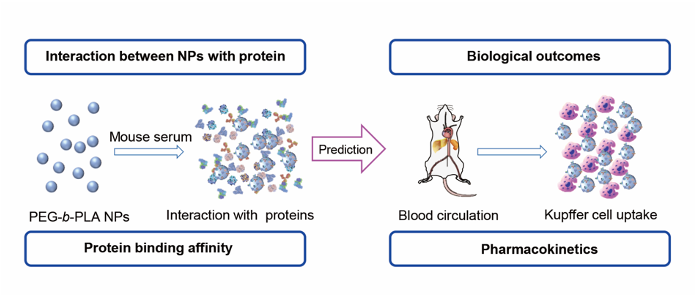Polymeric nanoparticles (NPs) are important category ofdrug delivery systems, and their in vivo fate is closely associated with delivery efficacy. Once entering bloodstream, NPs immediately interact with serum proteins and form “protein corona” on the surface. Previously reported approaches for analyzing protein corona based on Mass Spectrometry to predict the in vivo fate of different NPs have been shown to be reliable but complicated and time-consuming. Thus, we tried to develop a simple approach for predicting the in vivo fate of polymeric NPs with different protein binding affinities. We found that the protein binding affinity of polymeric NPs could be a direct indicator of their pharmacokinetics.
In this work, a series of poly(ethylene glycol)-block-poly(D,L-lactide) (PEG-b-PLA) NPs with different protein binding behaviors was prepared, and their protein binding affinities, denoted as the equilibrium association constant (KA), were examined to correlate with in vivo fate of NPs. We found the maximum concentration, the area under the plasma concentration–time curve and the mean residence time were negatively linearly dependent, while Kupffer cell uptake was positively linearly dependent on KA. The reliability of our approach for in vivo fate prediction was further confirmed using PEEP-b-PLA (poly(methoxyethyl ethylene phosphate)-block-poly(D,L-lactide)) and PVP-b-PLA (poly(vinylpyrrolidone)-block-poly(D,L-lactide)) NPs, the linear relationship between the KA value and their PK parameters further suggested that the protein binding affinity of polymeric NPs could be a direct indicator of their pharmacokinetics.

This study has recently been published in ACS Nano (doi:10.1021/acsnano.9b10015) titled “Protein Binding Affinity of Polymeric Nanoparticles as a Direct Indicator of Their Pharmacokinetics”. This work is supported by National Key R&D Program of China, the National Natural Science Foundation of China, the Program for Guangdong Introducing Innovative and Entrepreneurial Teams, Guangdong Provincial Pearl River Talents Program, Outstanding Scholar Program of Guangzhou Regenerative Medicine and Health Guangdong Laboratory, the Natural Science Foundation of Guangdong Province and the China Postdoctoral Science Foundation.
